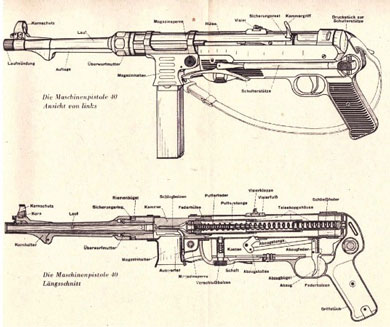|
mpforty.com |
|
|
The MP40 History A submachine gun is an automatic carbine designed to fire pistol cartridges. Invented during World War I (1914-1918) the zenith of submachine gun use was reached during 1939-1945, World War II. Due to poor accuracy past 50-100 yards and their inability to penetrate their targets at mid range, the submachine gun has been replaced by carbine-length assault rifles in military use. Police SWAT teams still value submachine guns for its original intend of use; accuracy in burst and fully automated mode combined with their lighter weight in close range situations. In the early 20th century, experiments were made by converting stocked pistols from semi to fully automatic. The trench warfare during World War I triggered the development of dedicated submachine guns in 1915 based on a developmental order of the German rifle testing Commission in Spandau, Germany. |
|
|
Initial attempts to modify the Luger and Mauser C96 pistols failed and it was determined that a new type of weapon was needed. The development team at the Bergmann Waffenfabrik consisted of several technicians including Theodor Bergmann and Hugo Schmeisser, creating the MP18.1. Full scale production did not begin unitl early 1918. The MP18.1 proved to be an excellent weapon. Its concept was well proven in trench fights. Its basic design directly influenced later submachine gun designs and showed its superiority versus the regular infantry rifle in urban combat and mobile warfare as well as in guerrilla warfare. The Bergmann MP18.1 represents a milestone both in terms of armament technology and warfare tactics. It opened the way for a whole new class of weapons and triggered the research for lighter automatic firearms to be used by mobile troops. Its first direct competitors did not see service in World War I, but most of them saw use in all the limited conflicts taking place in the inter-war period. In Germany some improvements on the MP18 were employed, namely the MP28/II and then MP34. |
 |
|
The MP 40 descended from its predecessor, the MP 38, which was in turn based on the MP 36, a prototype made of machined steel. The MP 36 was developed independently by Erma Werke's Berthold Geipel with funding from the German Army. It took design elements from Heinrich Vollmer's VPM 1930 and EMP. Vollmer then worked on Berthold Geipel's MP 36 and in 1938 submitted a prototype to answer a request from the German Armament services for a new submachine gun, which was adopted as MP 38. The MP 38 was a simplification of the MP 36, and the MP 40 was a further simplification of the MP 38, with certain cost-saving alterations, notably in the more extensive use of stamped steel rather than machined parts. The MP 40 was often called the "Schmeisser" by the Allies, after weapons designer Hugo Schmeisser. Schmeisser had designed the MP 18, which was the first mass-produced submachine gun, and saw extensive service at the end of the First World War. He did not, however, design the MP 40, although he held a patent on the magazine. He later designed the MP 41, which was an MP 40 with a wooden rifle stock and a selector, identical to those found on the earlier MP 28 submachine gun. The MP 41 was not introduced as a service weapon with the German Army, but saw limited use with some SS and police units. |
|
|
© mpforty.com |
|